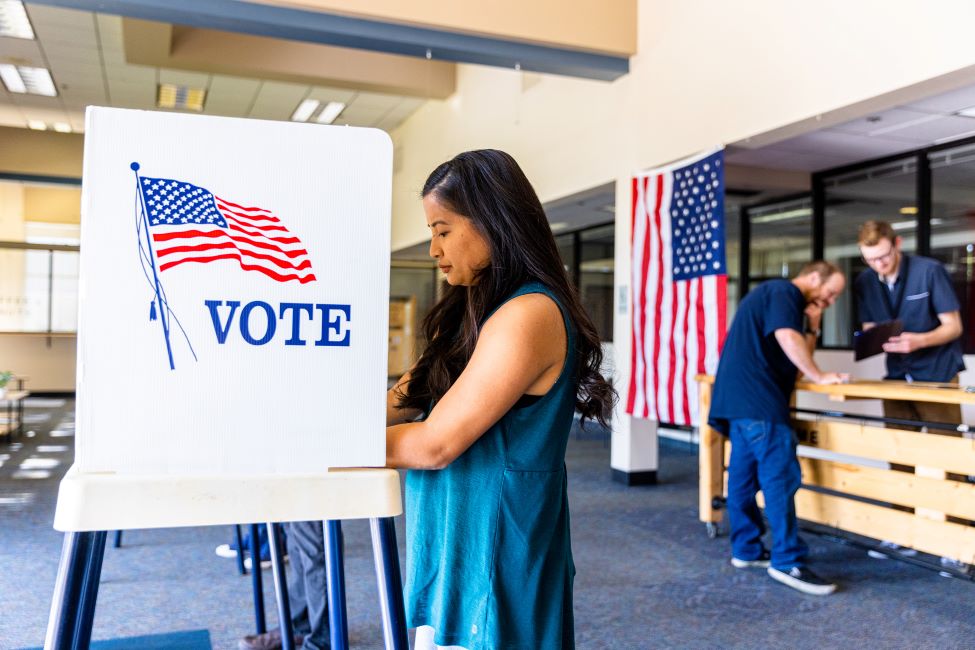FAU/Mainstreet Poll: Harris Narrows Trump's Lead to 5 Points

Voters share thoughts on historical election events
A new poll of U.S. voters conducted by Florida Atlantic University’s Political Communication and Public Opinion Research Lab (PolCom Lab) and Mainstreet Research USA highlights current voter leanings that were examined immediately before U.S. President Joe Biden announced he was leaving the race. The results also may point to challenges and opportunities for both parties in the election ahead.
Harris Narrows Race to 49-44, Reversing Democratic Slide
The race was moving away from Biden who had fallen behind former U.S. President Donald Trump 49% to 41%, the largest deficit since the PolCom Lab and Mainstreet Research USA’s polling began. However, U.S. Vice President Kamala Harris pulls within 5 points of Trump among likely voters (44% to 49%). Harris’ gains occurred prior to the endorsement by Biden and are due in part to her strength with college educated voters and minority voters where she already leads.
The addition of Robert F. Kennedy, Jr. does little to change the race with Trump, gaining a point among likely voters if Kennedy is included 45% (Trump) to 39% (Harris). Even before Biden’s withdrawal, Harris consolidated much of the Democratic vote, capturing about 85% of likely Democratic-leaning voters. However, challenges remain in her potential bid for the presidency.
“Biden’s declining numbers make this candidate change an opportunity for Democrats to regroup and appeal to voters,” said Luzmarina Garcia, assistant professor of political science at FAU and PolCom Lab-affiliated researcher. “But reversing Trump and the GOP’s momentum will require swift party consolidation and a robust campaign.”
Harris Faces Uncertainty as Trump Surges
Among all likely voters, 57% want the delegates to the Democratic Convention to decide the nominee, while 43% choose to support Harris as the nominee. When limited to Democrats, Harris was preferred by 62% of voters; however, 38% of Democrats still reported that they preferred the decision be made at the convention.
“On the whole, there does appear to be a solid base of support for Harris in the Democratic Party,” said Kevin Wagner, Ph.D., co-director of FAU’s PolCom Lab and professor of political science. “But there is still substantial uncertainty. Some Democratic voters are still looking for another candidate. Harris has time to unify the party before the convention, but she needs to move quickly, or this could potentially spin out of control for the Democrats.”
Harris Faces Favorability Gap at Campaign Outset
Prior to Biden’s race withdrawal, when asked about Harris, 50% viewed her unfavorably, while only 44% had a favorable opinion, a 6-point deficit. Meanwhile, voters were sharply divided on Trump, giving him a positive approval rating of 49% with 48% disapproving. Trump continues to do well with white non-college voters.
“I would be cautious about reading too much into Harris’ early numbers, as many voters have not yet focused on her as a leading candidate,” Garcia said. “The key will be how she is viewed after becoming the nominee and consolidating the party vote.”
The analysis in this report is based on a survey conducted from Friday, July 19 to Sunday, July 21, 2024, among 797 registered voters, living in the U.S. Data collection was halted when U.S. President Biden announced the termination of his campaign to avoid any post-announcement bias in the data. The survey was conducted in English and Spanish using IVR and an online panel. It represents the U.S. voting population with weights applied for gender, race, education and past vote. Party ID is determined by the party each respondent most identifies with, as some states do not have voter registration by party. Since the poll was partially completed online, a margin of error cannot be assigned. However, a poll of this size would have a margin of error of +/- 3.5% at the 95% confidence level. Margins of error are higher in each subsample. For full methodologies, visit www.faupolling.com/about. To hear and see PolCom Researchers discuss this poll, follow us on YouTube.
-FAU-
Latest Research
- VR Could be a Gamechanger in Police-Civilian Crisis EncountersAn FAU College of Social Work and Criminal Justice study immersed police officers in virtual reality training using a realistic mental illness scenario to enhance empathy and complement traditional training.
- STEM Teachers in High-need Schools Resilient Despite ChallengesAn FAU College of Education researcher collaborated on a study examining 30 years of STEM teacher trends, focusing on qualifications and changes in high-need, primarily high-poverty U.S. schools.
- Alcohol-Related Deaths in the U.S. More than Double from 1999 to 2020FAU researchers explored overall trends as well as by age, gender, race and region. The sharpest spike occurred among 25-34-year-olds (nearly fourfold), while individuals aged 55-64 had the highest rates.
- FAU REPORT: Consumers Face Elevated Prices Despite Waning InflationThe years of high inflation appear to be over as inflation is now in line with the Federal Reserve's target, though prices will likely remain permanently elevated, according to the Monthly Inflation Report.
- FAU Engineers Win NSF Grant for Unique School of AI Bio-Robotic FishA school of bio-robotic fish with advanced sensors will create a versatile network capable of maneuvers and station-keeping beyond current vehicles in shallow coastal areas and in deep ocean environments.
- FAU Poll: Presidential Race Tightens Across Key Battleground StatesLatest FAU polls reveal a highly competitive landscape in the battleground states of Michigan, Pennsylvania and Wisconsin, with both the presidential and U.S. Senate races showing narrow Democratic leads.






